
The Fiat CR.32 was an Italian biplane fighter used in the Spanish Civil War and the Second World War. Designed by the aeronautical engineer Celestino Rosatelli, it was a compact, robust and highly manoeuvrable aircraft for its era, leading to it being a relatively popular fighter during the 1930s.

The Caproni Ca.3 is an Italian heavy bomber of World War I and the postwar era. It was the most produced version of the series of aircraft that began with the 1914 Caproni Ca.1 and continued until the more powerful 1917 Caproni Ca.5 variant.
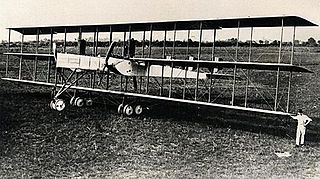
The Caproni Ca.4 was an Italian heavy bomber of the World War I era.

The Albatros C.III was a German two-seat general-purpose biplane of World War I, built by Albatros Flugzeugwerke. The C.III was a refined version of the successful Albatros C.I and was eventually produced in greater numbers than any other C-type Albatros.

The Albatros C.I,, was the first of the successful C-series of two-seat general-purpose biplanes built by Albatros Flugzeugwerke during World War I. Based on the unarmed Albatros B.II, the C.I reversed the pilot and observer seating so that the observer occupied the rear cockpit which was fitted with a ring-mounted 7.92 mm (0.312 in) Parabellum MG14 machine gun.
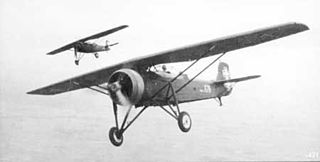
The ANBO IV was a reconnaissance aircraft used by the Lithuanian Air Force in World War II, designed by Lithuanian aircraft designer Antanas Gustaitis. The Lithuanian ANBO 41 was far ahead of the most modern foreign reconnaissance aircraft of that time in structural features, and most importantly in speed and in rise time. All ANBO 41 aircraft were likely destroyed during World War II.
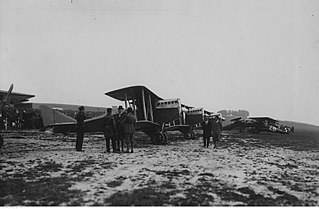
The Ansaldo A.300 was an Italian general-purpose biplane aircraft built by the Ansaldo company of Turin from 1920 to 1929. It also served as a light bomber, transport, fighter and reconnaissance aircraft, and finally as an advanced trainer, with examples in service as late as 1940. 50 examples were also license-built in Poland at ZM E. Plage & T. Laśkiewicz, but were not a success due to poor quality.
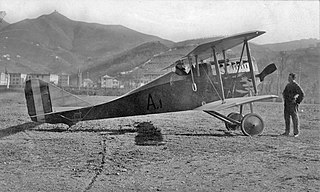
The Ansaldo A.1, nicknamed "Balilla" after the Genoan folk-hero, was Italy's only domestically-designed fighter aircraft of World War I to be produced in Italy. Arriving too late to see any real action, it was however used by both Poland and the Soviet Union in the Polish-Soviet War of 1919–1921.

The Ansaldo SVA was a family of Italian reconnaissance biplane aircraft of World War I and the decade after. Originally conceived as a fighter, the SVA was found inadequate for that role. Nevertheless, its impressive speed, range and operational ceiling, with its top speed making it one of the fastest of all Allied combat aircraft in World War I, gave it the right properties to be an excellent reconnaissance aircraft and even light bomber. Production of the aircraft continued well after the war, the final examples were delivered during 1918.

The Fiat CR.20 was an Italian biplane fighter used during the 1920s and 1930s. Designed by Celestino Rosatelli, it represented an intermediate step from the early biplane CR.1 and the later, successful series CR.30, CR.32 and CR.42.

The Aviatik B.I is a German two-seat reconnaissance biplane designed and built by the Automobil und Aviatik AG company, who until then had produced copies of French designs.

The Maurice Farman MF.11 Shorthorn is a French aircraft developed before World War I by the Farman Aviation Works. It was used as a reconnaissance and light bomber during the early part of World War I, later being relegated to training duties.

The Fiat CR.1 was an Italian biplane fighter aircraft of the 1920s. Of wood-and-fabric construction, it was designed by Celestino Rosatelli, from whom it gained the 'CR' designation. Its most distinctive feature was that the lower wings were longer than the upper ones.

The Caproni Ca.100 was the standard trainer aircraft of the Regia Aeronautica in the 1930s. Large numbers of this tandem, two-seat, biplane were built, powered by different engines.
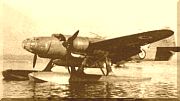
The Fiat RS.14 was an Italian long-range maritime strategic reconnaissance floatplane. The RS.14 was a four/five seat all-metal cantilever low/mid-wing monoplane powered by two wing-mounted 626 kW (840 hp) Fiat A.74 R.C.38 engines. It had a conventional cantilever tail unit with a single fin and rudder. Its undercarriage consisted of two large floats on struts. It had a glazed nose for an observer or bomb aimer. The pilot and copilot sat side by side with a wireless operator's compartment behind them. In the bombing role the RS.14 was fitted with a long ventral gondola to carry various combinations of anti-submarine bombs.

The Fiat B.R. 1/4 was a light bomber series, developed in Italy shortly after World War I.

The Fiat G.80 was a military jet trainer developed in Italy in the 1950s, and was that country's first true jet-powered aircraft. It was a conventional low-wing monoplane with retractable tricycle undercarriage and engine air intakes on the fuselage sides. The pilot and instructor sat in tandem under a long bubble canopy.

The Pomilio PE was a First World War Italian armed reconnaissance biplane designed and built by the Pomilio brothers. It was developed from the earlier Pomilio PC and PD.

The Lohner L was a reconnaissance flying boat produced in Austria-Hungary during World War I. It was a two-bay biplane of typical configuration for the flying boats of the day, with its pusher engine mounted on struts in the interplane gap. The pilot and observer sat side by side in an open cockpit, and both the upper and lower sets of wings featured sweepback.

The Heinkel HE 5, produced in Sweden as the Svenska S 5 and nicknamed the "Hansa", was a reconnaissance floatplane built during the 1920s. It was a further development of the HE 1, sharing its same basic configuration as a low-wing, strut-braced monoplane. The HE designation also refers to the monoplane construction, standing for Heinkel Eindecker.




















